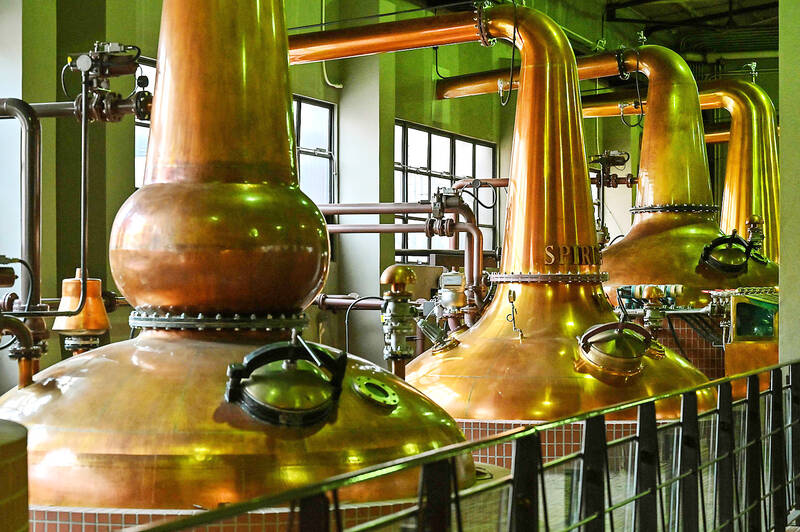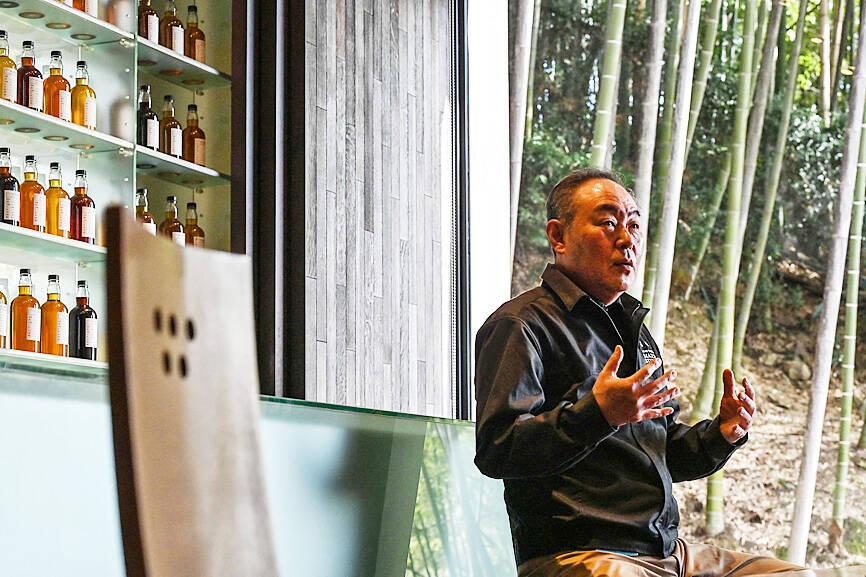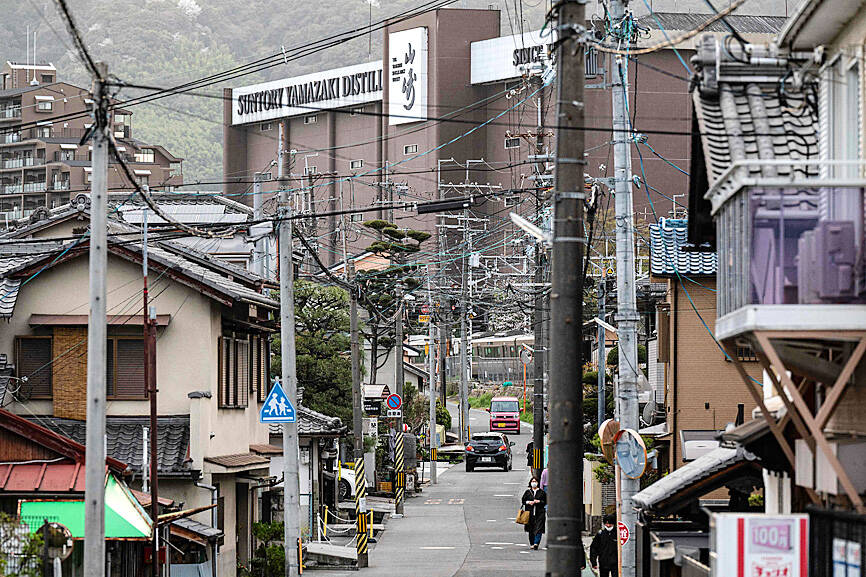The famed Yamazaki Distillery marks its 100th anniversary this year with plenty to celebrate, as Japan’s acclaimed aged whiskeys command increasingly eye-watering prices thanks to growing demand and longstanding shortages.
Japan’s oldest distillery has sat at the foot of a mountain outside Kyoto since it was built by Shinjiro Torii, the founder of Yamazaki maker Suntory, who wanted to make whiskey suited to a Japanese palate.
It is largely foreign demand, along with the relative scarcity of the most desirable decades-old bottles, that has pushed prices sky-high.

Photo: AFP
A bottle of Yamazaki 55, with an official retail price of ¥3 million (US$21,156), sold for US$600,000 at a Sotheby’s auction in New York last year. That was still well below the record US$795,000 set at a Hong Kong auction in 2020.
And in Japan’s upscale Ginza district, a more modest Yamazaki 18 with a manufacturer’s price of ¥32,000 is on sale for ¥120,000.
Suntory does not disclose production volume, but the distillery’s senior general manager Takahisa Fujii said it has risen dramatically over the past 20 years.

Photo: AFP
Warning: Excessive consumption of alcohol can damage your health
The company announced plans this year to pump ¥10 billion into its Yamazaki and Hakushu distilleries, but demand still far outstrips capacity.
“We have received so many requests for our whiskey from customers around the world, so we are trying to respond to them as best we can,” Fujii said.
The Yamazaki Distillery welcomes dozens of visitors from Japan and abroad each day, but those hoping to stock up on aged varieties come away disappointed.

Photo: AFP
Peter Kaleta, a 35-year-old visitor who runs a bar in Poland, was crestfallen after he could not buy one of his favorites.
It is a “must-have” for whiskey bars, he added, calling the lack of aged varieties “kind of depressing.”
Junpei Kusunoki, manager of Tokyo Whiskey Library, a bar in the chic Omotesando district, is no stranger to the struggle for supply.
“The whiskey boom is back,” he said. “There’s a quota in Omotesando area, so it’s a war against competitors. We’re trying everything to rake in” bottles.
The location of Yamazaki’s distillery is a world away from the Scottish terroir most associated with whiskey, but Fujii says the site was chosen for the region’s famed water.
Its renown traces back to the 16th century, when Japanese tea master Sen no Rikyu labored nearby.
“You can’t make good liquor without good water,” Fujii said, adding that the humid and misty environment helps age the whiskey.
The distillery’s unique range of copper stills in different shapes and sizes also contribute to the brand’s particular profile, he said.
Yamazaki’s layered and well-balanced flavors are considered a good match for Japanese cuisine, Fujii said.
There are now around 100 distilleries across Japan, according to whiskey critic Mamoru Tsuchiya, with a reputation for quality helping boost the profile of its tipples.
The exorbitant prices are the result of a “lack of whiskey at a time when demand from abroad has increased exponentially,” he said.
Today’s success belies a 20-year downturn after domestic consumption peaked in 1983.
“Sales were declining every year, so the impact was big,” said Nobuyuki Akiyama, head of Suntory’s whiskey marketing division.
Things only started to turn around in the early 2000s, when Nikka Whiskey’s Yoichi 10 and Yamazaki 12 received prestigious international industry awards.
And 2003 saw Suntory’s Hibiki 17 play a starring role in the hit movie Lost in Translation, featuring Bill Murray promoting the drink with the line: “For relaxing times, make it Suntory time.”
Domestic sales also recovered just as international demand began to rise, thanks in part to the revival of highballs, a mix of whiskey and soda.
A 2015 television drama based on the life of Nikka Whiskey’s founder also helped drive renewed domestic interest.
The sudden uptick came too quickly for companies that have to plan production decades in advance.
“We have Hibiki 30, for example, where we need to think about how many bottles we should make 30 years into the future,” said Akiyama, adding it was “impossible” to predict the market so far in advance.
For now, sales look likely to continue growing, with exports surging to ¥56 billion last year, 14 times more than a decade earlier.
Judith Ly, a German visitor to the Yamazaki Distillery, said she makes an exception for Japanese whiskey.
“Normally I don’t drink whiskey, but I like the taste,” she said. “It’s smooth. It’s easy to drink.”

SEEKING CLARITY: Washington should not adopt measures that create uncertainties for ‘existing semiconductor investments,’ TSMC said referring to its US$165 billion in the US Taiwan Semiconductor Manufacturing Co (TSMC, 台積電) told the US that any future tariffs on Taiwanese semiconductors could reduce demand for chips and derail its pledge to increase its investment in Arizona. “New import restrictions could jeopardize current US leadership in the competitive technology industry and create uncertainties for many committed semiconductor capital projects in the US, including TSMC Arizona’s significant investment plan in Phoenix,” the chipmaker wrote in a letter to the US Department of Commerce. TSMC issued the warning in response to a solicitation for comments by the department on a possible tariff on semiconductor imports by US President Donald Trump’s

The government has launched a three-pronged strategy to attract local and international talent, aiming to position Taiwan as a new global hub following Nvidia Corp’s announcement that it has chosen Taipei as the site of its Taiwan headquarters. Nvidia cofounder and CEO Jensen Huang (黃仁勳) on Monday last week announced during his keynote speech at the Computex trade show in Taipei that the Nvidia Constellation, the company’s planned Taiwan headquarters, would be located in the Beitou-Shilin Technology Park (北投士林科技園區) in Taipei. Huang’s decision to establish a base in Taiwan is “primarily due to Taiwan’s talent pool and its strength in the semiconductor

An earnings report from semiconductor giant and artificial intelligence (AI) bellwether Nvidia Corp takes center stage for Wall Street this week, as stocks hit a speed bump of worries over US federal deficits driving up Treasury yields. US equities pulled back last week after a torrid rally, as investors turned their attention to tax and spending legislation poised to swell the US government’s US$36 trillion in debt. Long-dated US Treasury yields rose amid the fiscal worries, with the 30-year yield topping 5 percent and hitting its highest level since late 2023. Stocks were dealt another blow on Friday when US President Donald

UNCERTAINTY: Investors remain worried that trade negotiations with Washington could go poorly, given Trump’s inconsistency on tariffs in his second term, experts said The consumer confidence index this month fell for a ninth consecutive month to its lowest level in 13 months, as global trade uncertainties and tariff risks cloud Taiwan’s economic outlook, a survey released yesterday by National Central University found. The biggest decline came from the timing for stock investments, which plunged 11.82 points to 26.82, underscoring bleak investor confidence, it said. “Although the TAIEX reclaimed the 21,000-point mark after the US and China agreed to bury the hatchet for 90 days, investors remain worried that the situation would turn sour later,” said Dachrahn Wu (吳大任), director of the university’s Research Center for